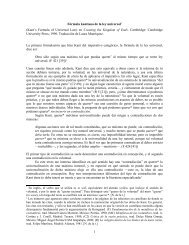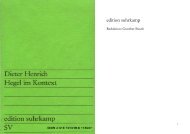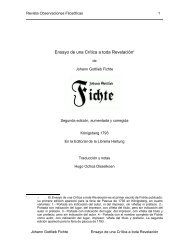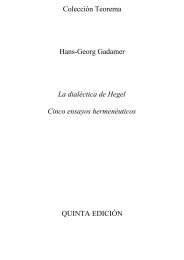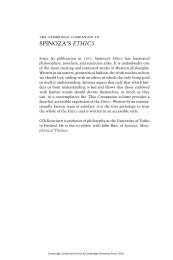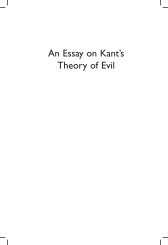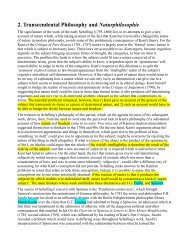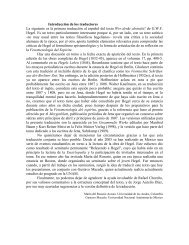- Page 2:
This page intentionally left blank
- Page 6:
CAMBRIDGE TEXTS IN THE HISTORY OF P
- Page 10:
CAMBRIDGE UNIVERSITY PRESS Cambridg
- Page 14:
Contents is then asked whether they
- Page 18:
Introduction Spinoza’s aims The T
- Page 22:
Introduction of society more genera
- Page 26:
Introduction The ‘tr ue me aning
- Page 30:
Introduction occurrences they canno
- Page 34:
Introduction often consciously anta
- Page 38:
Introduction Spinoza claims that Ch
- Page 42:
Introduction to form a tactical and
- Page 46:
Introduction of the Early Enlighten
- Page 50:
Introduction churches in his view a
- Page 54:
Introduction deal were the Dutch an
- Page 58:
Introduction and consequently the m
- Page 62:
Introduction should b e p e r mitte
- Page 66:
Introduction The ¢rst of many publ
- Page 70:
Introduction certainly the historic
- Page 74:
1656 July 27, the twenty-four-year-
- Page 78:
Further reading The best recent acc
- Page 82:
Further reading ‘Hobbes and Spino
- Page 86:
Note on the text and translation Th
- Page 90:
Note on the text and translation Bu
- Page 94:
Note on the text and translation un
- Page 100:
Preface 5 [1] If men were always ab
- Page 104:
Preface been most in£uential with
- Page 108:
Preface servitude, as well as our a
- Page 112:
Preface make a fresh examinati on o
- Page 116:
Preface which is that this lib e r
- Page 120:
chapter 1 15 On prophecy [1] Prophe
- Page 124:
On prophecy [6] Truly, however, wha
- Page 128:
On prophecy express or explain in i
- Page 132:
On prophecy ‘But that is not how
- Page 136:
On prophecy spirit’ hatred and me
- Page 140:
On prophecy Further,‘spirit of Go
- Page 144:
On prophecy men’, ‘men were ¢l
- Page 148:
chapter 2 On the prophe ts [1] It f
- Page 152:
On the prophets and miracles to tes
- Page 156:
On the prophets ignorant of future
- Page 160:
On the prophets all remained obscur
- Page 164:
On the prophets put it this way, th
- Page 168:
On the prophets supreme God, or (to
- Page 172:
On the prophets command of the law.
- Page 176:
On the prophets although the words
- Page 180:
chapter 3 On the vocation of the He
- Page 184:
On the vocation of the Hebrews decr
- Page 188:
On the vocation of the Hebrews For
- Page 192:
On the vocation of the Hebrews Scr
- Page 196:
On the vocation of the Hebrews down
- Page 200:
On the vocation of the Hebrews the
- Page 204:
On the vocation of the Hebrews As f
- Page 208:
chapter 4 On the divine law [1] The
- Page 212:
On the divine law ‘a constant and
- Page 216:
On the divine law [6] If we now con
- Page 220:
On the divine law as a ruling, that
- Page 224:
On the divine law common people and
- Page 228:
On the divine law be sweet to you,
- Page 232:
On ceremonies and narratives people
- Page 236:
On ceremonies and narratives God’
- Page 240:
On ceremonies and narratives they a
- Page 244:
On ceremonies and narratives could
- Page 248:
On ceremonies and narratives [16] L
- Page 252:
On ceremonies and narratives chroni
- Page 256:
chapter 6 81 On miracles [1] Just a
- Page 260:
On miracles is not distinct from Go
- Page 264:
On miracles without risk of doubt.
- Page 268:
On miracles but cannot to be made o
- Page 272:
On miracles This is why the Jews an
- Page 276:
On miracles [15] Yet someone may pe
- Page 280:
On miracles But this is not the sol
- Page 284:
On miracles I could not infer from
- Page 288:
chapter 7 97 On the interpretation
- Page 292:
On the interpretation of Scripture
- Page 296:
On the interpretation of Scripture
- Page 300:
On the interpretation of Scripture
- Page 304:
On the interpretation of Scripture
- Page 308:
On the interpretation of Scripture
- Page 312:
On the interpretation of Scripture
- Page 316:
On the interpretation of Scripture
- Page 320:
On the interpretation of Scripture
- Page 324:
On the interpretation of Scripture
- Page 328:
On the interpretation of Scripture
- Page 332:
Pentateuch, Joshua, Judges, Ruth, S
- Page 336:
Pentateuch, Joshua, Judges, Ruth, S
- Page 340:
Pentateuch, Joshua, Judges, Ruth, S
- Page 344:
Pentateuch, Joshua, Judges, Ruth, S
- Page 348:
Pentateuch, Joshua, Judges, Ruth, S
- Page 352:
Pentateuch, Joshua, Judges, Ruth, S
- Page 356:
Furtherqueries 32.32). 1 It is word
- Page 360:
Furtherqueries and that his words h
- Page 364:
Furtherqueries It begins,‘Saulwas
- Page 368:
Furtherqueries this topic and chall
- Page 372:
Furtherqueries appears penned corre
- Page 376:
Furtherqueries illustrate all this
- Page 380:
Furtherqueries preserve a space of
- Page 384:
Remaining Old Testament books Philo
- Page 388:
Remaining Old Testament books Again
- Page 392:
Remaining Old Testament books books
- Page 396:
Remaining Old Testament books i m m
- Page 400:
Remaining Old Testament books sever
- Page 404:
chapter 11 Where it is asked whethe
- Page 408:
Apostles and prophets amount to no
- Page 412:
Apostles and prophets preach to eve
- Page 416:
Apostles and prophets [7] However,
- Page 420:
chapter 12 On the true original tex
- Page 424:
Divine law and the word of God in s
- Page 428:
Divine law and the word of God lett
- Page 432:
Divine law and the word of God (3)
- Page 436:
Divine law and the word of God huma
- Page 440:
The teachings of Scripture [2] I ne
- Page 444:
The teachings of Scripture the divi
- Page 448:
The teachings of Scripture [9] It i
- Page 452:
Faith and philosophy p e rs e cute
- Page 456:
Faith and philosophy does not love,
- Page 460:
Faith and philosophy (5) Worship of
- Page 464:
Faith and philosophy condemns as he
- Page 468:
Theology and reason Although this a
- Page 472:
Theology and reason his own authori
- Page 476:
Theology and reason what is properl
- Page 480:
Theology and reason unadulterated a
- Page 484:
chapter 16 189 On the foundations o
- Page 488:
Foundations of the state means ^ by
- Page 492:
Foundations of the state such an ag
- Page 496:
Foundations of the state almost imp
- Page 500:
Foundations of the state sovereign;
- Page 504:
Foundations of the state even if th
- Page 508:
Foundations of the state Since by t
- Page 512:
The Hebrew state in the time of Mos
- Page 516:
The Hebrew state in the time of Mos
- Page 520:
The Hebrew state in the time of Mos
- Page 524:
The Hebrew state in the time of Mos
- Page 528:
The Hebrew state in the time of Mos
- Page 532:
The Hebrew state in the time of Mos
- Page 536:
The Hebrew state in the time of Mos
- Page 540:
The Hebrew state in the time of Mos
- Page 544:
The Hebrew state in the time of Mos
- Page 548:
The Hebrew state in the time of Mos
- Page 552:
The Hebrew state in the time of Mos
- Page 556:
The Hebrew state and its history su
- Page 560:
The Hebrew state and its history me
- Page 564:
The Hebrew state and its history le
- Page 568:
The Hebrew state and its history tr
- Page 572:
Sovereign powers and religion [3 ]
- Page 576: Sovereign powers and religion that
- Page 580: Sovereign powers and religion piety
- Page 584: Sovereign powers and religion absen
- Page 588: Sovereign powers and religion objec
- Page 592: Sovereign powers and religion these
- Page 596: Afreestate suppressing men’s awar
- Page 600: Afreestate time they submit their v
- Page 604: Afreestate it can all be avoided by
- Page 608: Afreestate understand nothing. Sure
- Page 612: Afreestate for their inner thoughts
- Page 616: Annotations [C hapte r 1 ] 251 Anno
- Page 620: Annotations [C hapte r 7 ] Annotati
- Page 624: Annotations travelling between Meso
- Page 630: Annotations A n notatio n 20 (p. 13
- Page 634: Annotations on, is a r idiculous ¢
- Page 638: Annotations certainly free to the e
- Page 642: Annotations 266 Annotation 38:(p.21
- Page 646: Index Abigail 29 ‘abovenature’,
- Page 650: Index philosopher xlvi, 37, 110, 11
- Page 654: Index 247, 249, 251, 252, 253, 255,
- Page 658: Kant Critique of Practical Reason (




